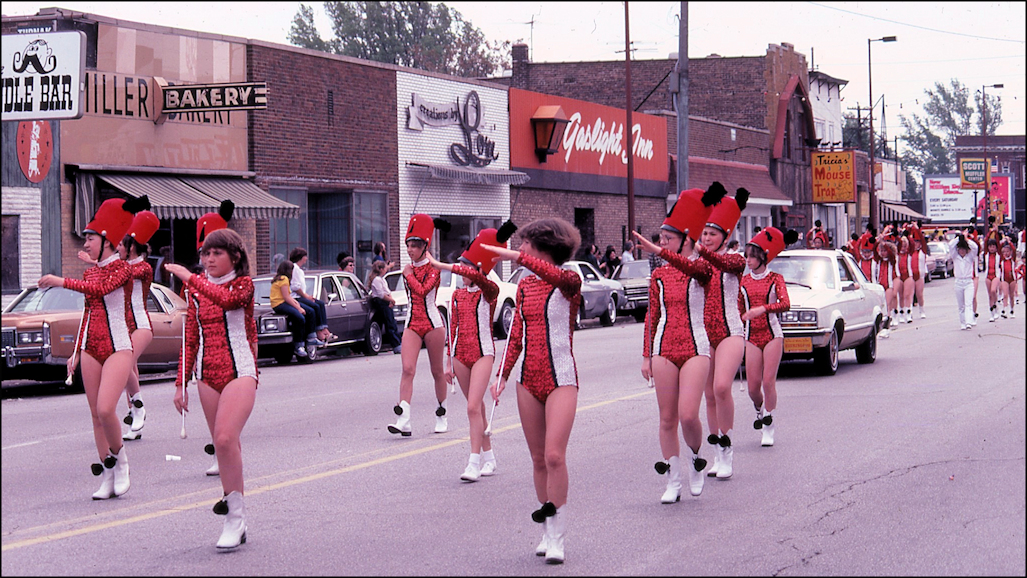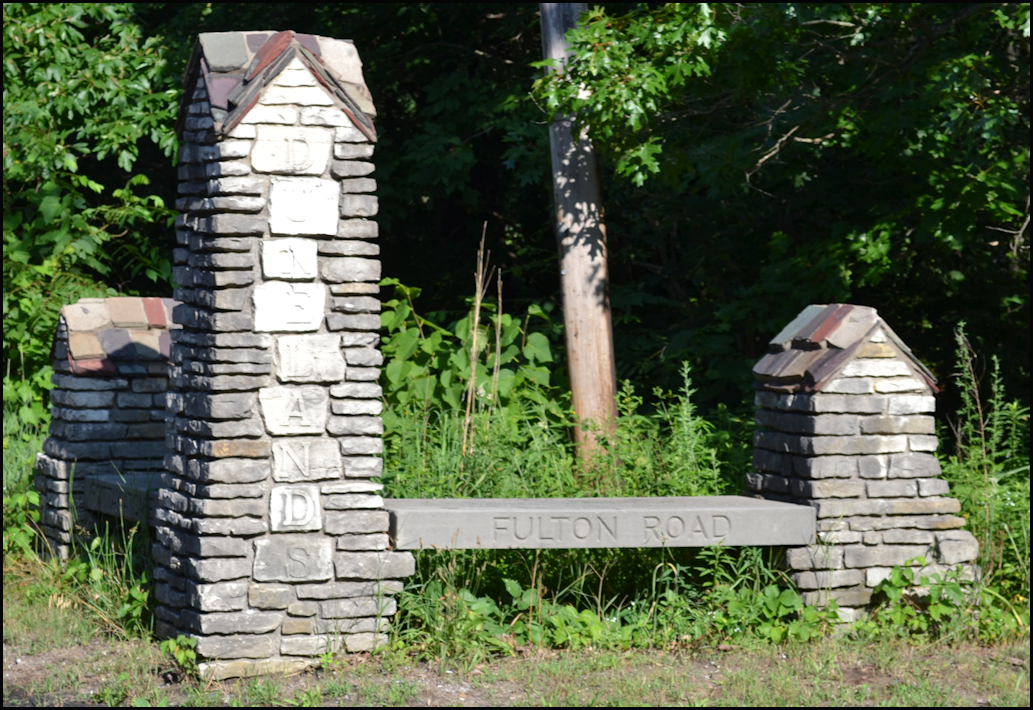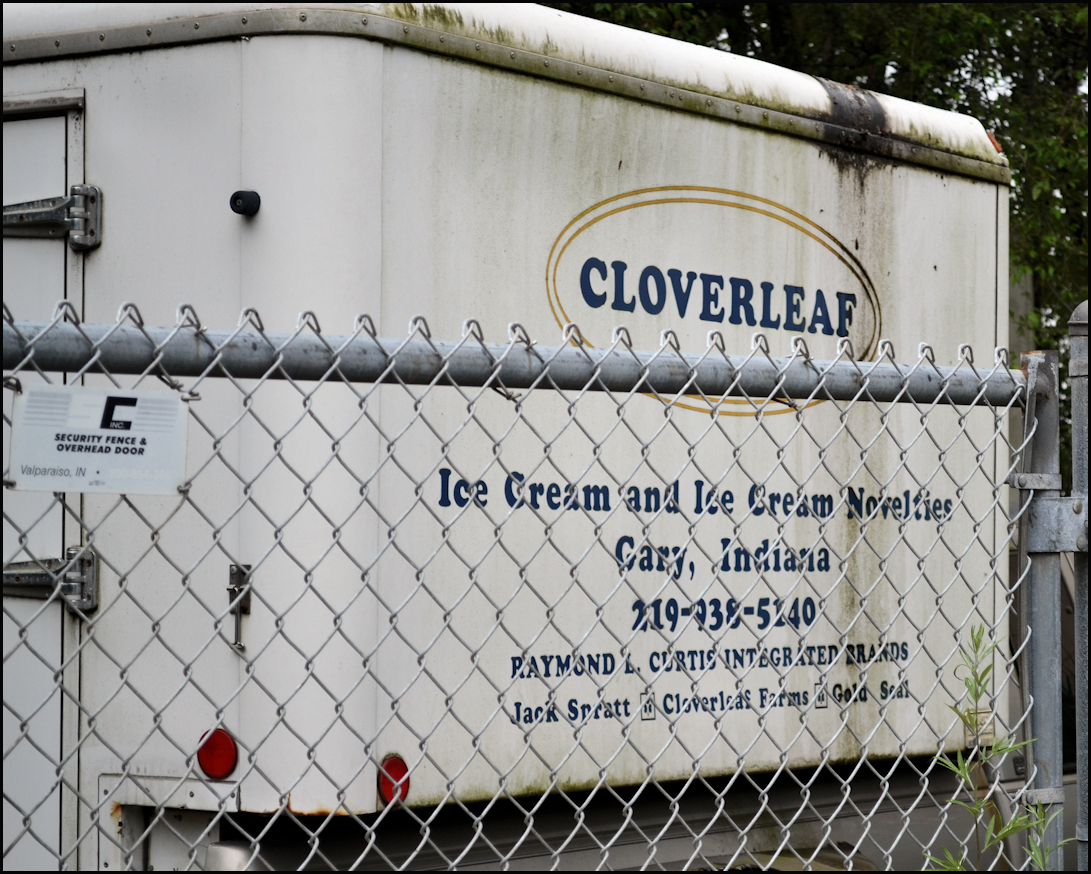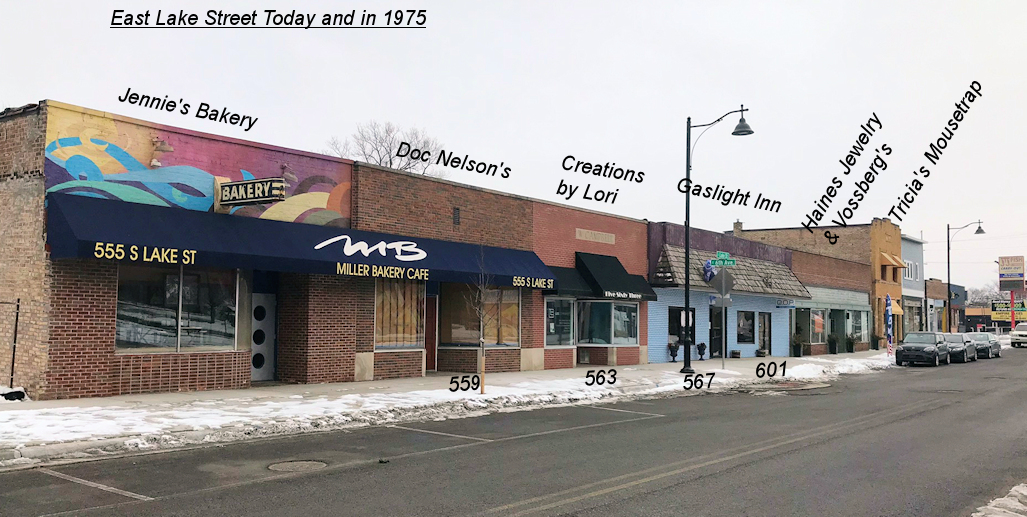Fulton Road, The Miller State Bank, Jack Spratt Ice Cream, and W.J. Fulton
(Fulton Road now known as Oak Ave. and County Line Road)
Have you ever wondered what “Fulton Road” comes from on that pylon seat at
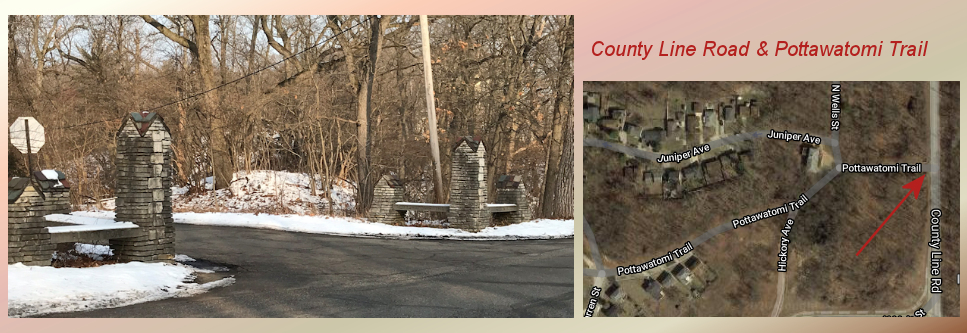 County Line Road and Pottawatomie Trail?
Or, maybe you’ve never noticed it.
County Line Road and Pottawatomie Trail?
Or, maybe you’ve never noticed it.
It was the original name of the road, and is uniquely tied to another brief, and long-gone, institution in Miller Beach, the Miller State Bank. What ties them together is William J. Fulton, a Miller resident, county commissioner, and interim mayor of Gary. But first, Fulton Road.
Oak Ave. and County Line Road were built as Fulton Road in 1925-1926
While the 1922 conceptual map of Lake Front (Marquette) Park shows only a “Future…” road leading east, one was needed and on May 19, 1924 the county commissioners awarded a contract to M.D. Heiny of Gary to build a road that would go north from Dunes Highway and turn west to the Bath House. The article in the Post-Tribune includes this description:
“The new road, which will pass through the very heart of the dune country, promises to be one of most beautiful yet built in this section of the state, giving a full view of the famous sand wonders. It will connect with Dunes highway at the Porter county line and proceed north along the county line for three-quarters of a mile.
It will then turn west for approximately one-half mile when it will swing slightly to the south. After continuing this direction for a quarter of a mile it will again swing directly west continuing for three-quarters of a mile, connecting with Gleason road near the Gary municipal bathhouse.” (Footnote: “Contract For Fulton Road Let To Heiny; Work To Be Started At Once,” Gary Post-Tribune, 20 May, 1924, page 1. ("At Once" was hardly to be the case.) (At the time any road leading to the park was called "Gleason road," by the press anyway.) )
They called it the W.J. Fulton road and would become what we know as County Line Road and Oak Ave. For some years after, it was known locally as both Oak and Fulton road. (Footnote: Neither Fulton or Oak are in the city directory in 1927. In 1929 the directory lists “Oak-From Montgomery east to city limits” with five residents, although there were likely more. Only three residents in 1930 but the next available directory, 1935, lists a number of people. Oak is referred to as Fulton road in a 1935 Times notice of a picnic of the Lake County Socialists at Wells Street Beach directing folks to take “…the old Dunes highway to Miller and turn left on Lake Street, follow Lake street north into the park and pick up Fulton road at the lake, just east of the public bath house.” Yet, only seven years earlier there is a reference to an auto accident at the intersection of Fulton Road and Oak Street east of the bath house.” It is not known when the moniker “Fulton Road” lost to “County Line Road.” )
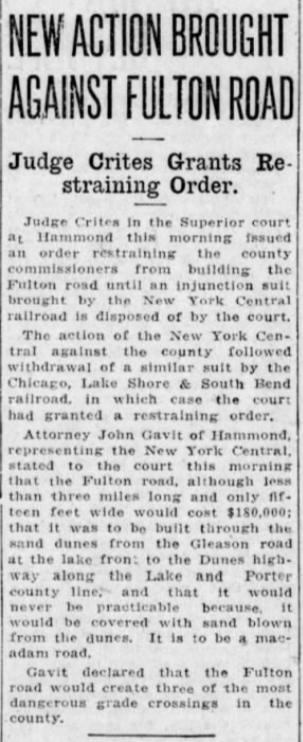 While the nation’s attention was focused on the famous Leopold and Loeb case going on in Chicago, money was raised through bond issues in
August of 1924.
While the nation’s attention was focused on the famous Leopold and Loeb case going on in Chicago, money was raised through bond issues in
August of 1924.
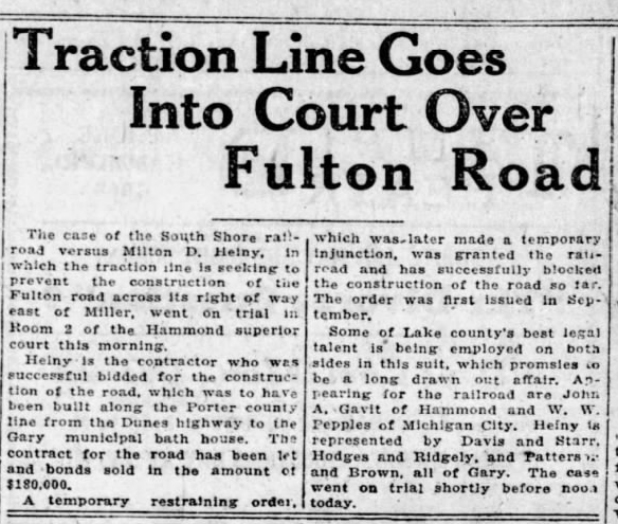 Objections to the road came immediately from the South Shore railway, which was granted a temporary injunction in
December against the contractor, Heiny, claiming that the cost to install “safety appliances” at the crossing would be excessive.
The injunction was made permanent in January. After the South Shore withdrew their objection to the
crossing, it was then taken up in June of 1925 by the New York Central RR which claimed the road would never be practical and would
create the three most dangerous crossings in the county.
Objections to the road came immediately from the South Shore railway, which was granted a temporary injunction in
December against the contractor, Heiny, claiming that the cost to install “safety appliances” at the crossing would be excessive.
The injunction was made permanent in January. After the South Shore withdrew their objection to the
crossing, it was then taken up in June of 1925 by the New York Central RR which claimed the road would never be practical and would
create the three most dangerous crossings in the county.
Interim mayor Fulton went downstate in July amid the national hubbub of the Scopes “Monkey Trial” to successfully plead his case to the Public Service Commission despite the further objections from the New York Central.
The contractor, M.D. Heiny, began work on August 3rd and was finished late summer of 1926, paving having been started exactly one year after he began. (Footnote:
The Times, August 3, 1925, page 5. The Times, August 3, 1926, page 5.
)
Only months later the first fatality occurred on February 27, 1927, taking the life of
Mrs. Maude Edwards who was killed when a westbound New York Central train hit the car she was riding in, throwing it into the path of an east bound train.
(Footnote:
The Times, 28 February 1927, pages 1 & 16.
“Woman On Joyride Killed As Two Trains Hit Car,” Gary Post-Tribune, May 28, 1927, page 1 & 2.
)
While the reported cause of the crash was brake failure, the crossing was at that time unprotected. The Gary Chief of Police announced that plans were
already being made by the railroads and the local safety board to hire watchmen at the crossing during the spring, summer and fall.
William J. Fulton was the man who got County Line Road and Oak Ave built.
Miller State Bank – 601 South Lake Street – and Jack Spratt Ice Cream shop.
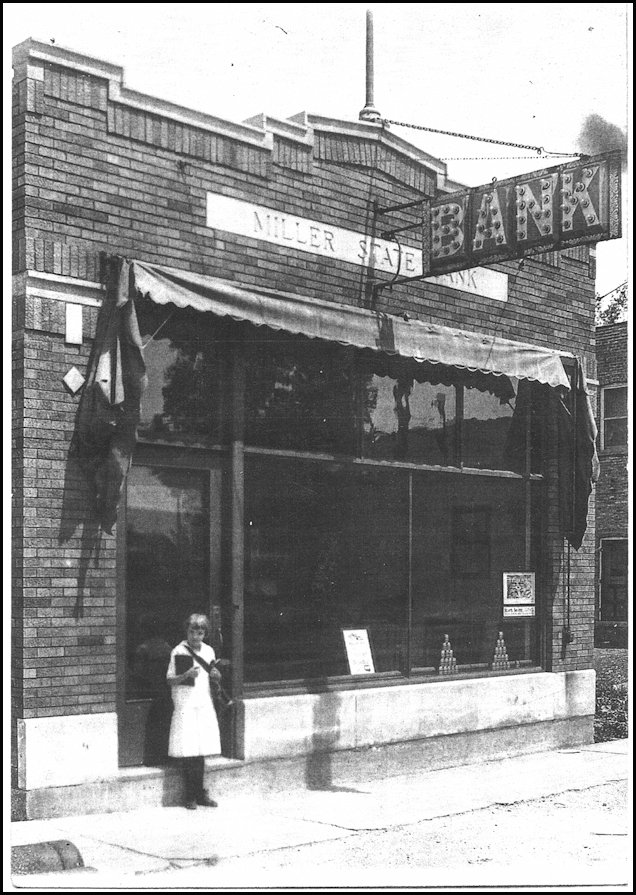
William J. Fulton, the nine-month Mayor of Gary, was a county commissioner when he bought sixty percent stock in the bank in June of 1929. The bank had been capitalized with $35,000 in June of 1924 with a nine-member Board of Directors that included two women. Construction from plans by Joseph L. Wildermuth began on July 16th at 601 S. Lake Street. Arthur Blank was to be bank president, C. Oliver Holmes, vice-president, and N. G. (Guy) Ayers, cashier. (Footnote: “Workmen Start On New Miller Bank Building Today,” Gary Post-Tribune, 15 July 1924, page 3. ) The building stood alone until just after World War II when the National Tea company built a grocery store adjoining it on the south. In the early 1950s Peacock Cleaners, a Gary concern, built and opened a branch to the north at 567 S. Lake.
Built during the prosperity of the 1920s, the bank hit the skids, along with thousands of other banks, with the crash of 1929. A run on the bank on December 27, 1930, seven months after Fulton took his own life, sealed the fate of the bank. Ex-depositors wouldn’t see the last refund until 1943, but its safe still resides at Ayres Real Estate.
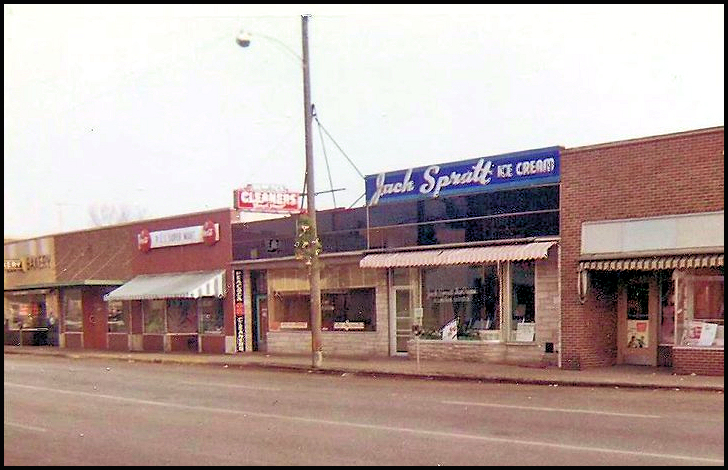
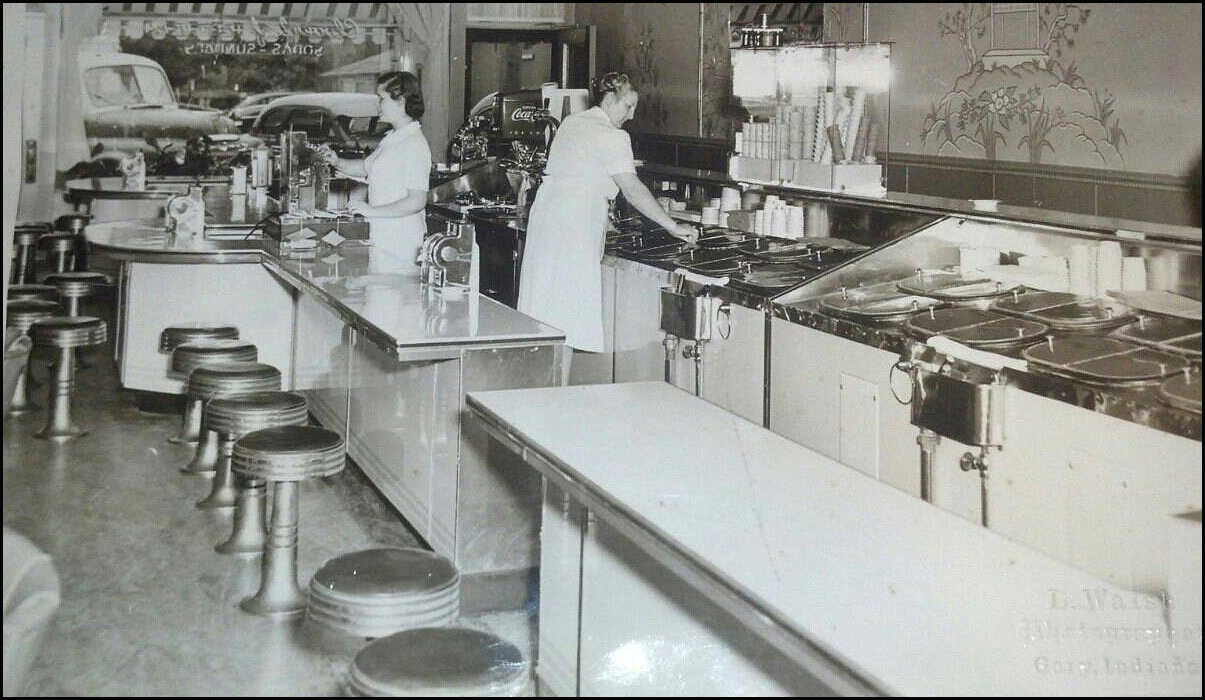
The building was not abandoned for long; by 1935 John J. Lennon had opened a confectionary shop at 601 S. Lake and by 1939 was selling an ice cream made by Cloverleaf Ice Cream Company on Connecticut street in Gary: Jack Spratt Ice Cream.(Footnote: Gary City Directories 1935 – 1973; Obit: John Lennon (Times, October 29, 2017). ) Operating for over 3 decades, the ice cream shop on Lake Street is still remembered fondly by folks who grew up in Miller and out-of-town beachgoers. Following the closing of the shop the building was taken over by John O'Meara, who combined it with the building to the north. He moved his Gaslight Inn there from 6001 Miller Ave., the “Point” building, where it had been since 1966. In the late 1990s the building was purchased by Miller resident Tom Collins who renovated it, returning to the two spaces it had been. He then, in August of 1998, donated 601 S. Lake Street to the police department to be a substation. (Footnote: "Gary police open substation in Miller", The Times, Aug. 13, 1998, page 12. ) It is now (2020) the C.O.P. (Community Orientated Policing) station of the Gary Police Department.
More on William J. Fulton
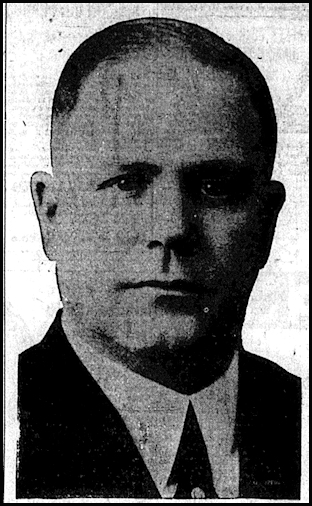 When “Bill” Fulton took his own life at his lake front home on Oak Ave in Miller, the Times published his suicide note on the front page alongside his picture.
The evening before, the county commissioner and former Gary Mayor had lost his bid for reelection and his campaign headquarters manager had been arrested with
conspiracy to violate the election laws. Pleading innocence of any wrong doing in his note, Fulton advised his son, then a Purdue student, to “…don’t get into politics!”
Trained as an engineer in his native Scotland, he came to Gary in 1907 to become the chief engineer for the Gary Land company and became the city engineer with the
election of Roswell O. Johnson as Mayor in 1914. Fulton became interim mayor in 1925 when Johnson, having won a second, non-consecutive, term, went to jail for
conspiring to violate the prohibition laws. Fulton lost his bid to become mayor in 1925 but was elected county commissioner for the first district two years later.
Besides his involvement in politics over the years he had built a successful business and was Gary manager of the Shell Petroleum corporation.
Following a funeral at his home on Oak Street a mile-long cortege escorted him to his burial place at Ridge Lawn Cemetery in Gary. (Footnote:
“W.J. Fulton Kills Himself,” The Lake County Times, May 8, 1930, page 1&6; Gary Post-Tribune, May 8, 1930, page 1 & 12.
)
When “Bill” Fulton took his own life at his lake front home on Oak Ave in Miller, the Times published his suicide note on the front page alongside his picture.
The evening before, the county commissioner and former Gary Mayor had lost his bid for reelection and his campaign headquarters manager had been arrested with
conspiracy to violate the election laws. Pleading innocence of any wrong doing in his note, Fulton advised his son, then a Purdue student, to “…don’t get into politics!”
Trained as an engineer in his native Scotland, he came to Gary in 1907 to become the chief engineer for the Gary Land company and became the city engineer with the
election of Roswell O. Johnson as Mayor in 1914. Fulton became interim mayor in 1925 when Johnson, having won a second, non-consecutive, term, went to jail for
conspiring to violate the prohibition laws. Fulton lost his bid to become mayor in 1925 but was elected county commissioner for the first district two years later.
Besides his involvement in politics over the years he had built a successful business and was Gary manager of the Shell Petroleum corporation.
Following a funeral at his home on Oak Street a mile-long cortege escorted him to his burial place at Ridge Lawn Cemetery in Gary. (Footnote:
“W.J. Fulton Kills Himself,” The Lake County Times, May 8, 1930, page 1&6; Gary Post-Tribune, May 8, 1930, page 1 & 12.
)
The Changing Face of Lake Street's east side 5 & 600 block.
The photo above with Jack Spratt Ice Cream shop is likely mid 1960s before Peacock Cleaners moved across the street.
About 1978 east side of the 5 to 600 block of Lake Street.
Left to right (north to south): (1) The Handle Bar (2) Miller Bakery before it became the Bakery Cafe with the building to its right which had been Dr. Nelson's office (3) Creations by Lori now Lee Companies offices (4) Peacock Cleaners & Jack Spratt combined into the Gaslight Inn (5) Combined law offices in 1974 Haines Jewelers & Vossberg's Governor's Shop (6) Tricia's Mouse Trap, now Lake Street Gallery.
